Research
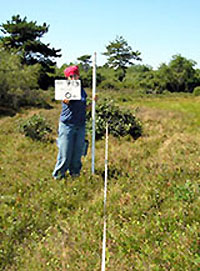 The Natural Resource Office also conducts research, projects, and surveys. A proposal will be developed and reviewed for each project.
The Natural Resource Office also conducts research, projects, and surveys. A proposal will be developed and reviewed for each project. Parcels of land on Cape Cod, Camp Edwards may be considered an ideal site for conducting field research. In the past, researchers affiliated with state universities, non-profit organizations, as well as state and federal environmental agencies have conducted surveys and research projects on Camp Edwards, either as contractors or independently. Any person that is affiliated with the aforementioned organizations, and is interested in conducting research on Camp Edwards, should submit a research proposal to the Camp Edwards Natural Resource Office for review.
The projects, research, and surveys that have been proposed include, but are not necessarily limited to, the following:
Wetlands Rehabilitation (1999-present)
The wetlands rehabilitation serves to reduce or eliminate soil erosion into wetlands or their buffers and to restore ponds to their historic conditions, if deemed beneficial to the natural resources of the wetlands. Activities include: removing soil that was deposited by erosion or filling, implementing erosion control techniques, revegetating wetland buffers, and closing roads adjacent to the wetlands. Prior to any disturbance in or near the wetlands of Camp Edwards, the Natural Resource Office will consult and coordinate with the Massachusetts DEP, NHESP, and appropriate local conservation commission. Notification of, and consultation with, the Wampanoag Tribe is required under Section 106 of the NHPA prior to excavation or earth-moving activities near all wetlands. Inadvertent discovery of cultural resources should be reported to the Camp Edwards Natural Resource Office. All necessary consultation and permitting procedures will be conducted prior to disturbing wetlands or regulated wetland buffers.
Road Closures (1999-present)
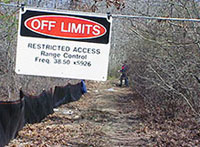 Roads that pose a threat to sensitive habitat areas have been seasonally or permanently closed as long as there is no net loss to maneuver areas (Table 8-1). These roads are most often associated with wetland buffers. Seasonal closures are from 1 March through 15 June and occur at designated roads throughout the training area that are within the 500 ft. regulatory buffer of a wetland.
Roads that pose a threat to sensitive habitat areas have been seasonally or permanently closed as long as there is no net loss to maneuver areas (Table 8-1). These roads are most often associated with wetland buffers. Seasonal closures are from 1 March through 15 June and occur at designated roads throughout the training area that are within the 500 ft. regulatory buffer of a wetland.
Table 8-1. Seasonal and permanent road closures on Camp Edwards.
| Road | Training Area | Seasonal Closure | Permanent Closure |
|---|---|---|---|
| Deep Bottom Pond Road | Bravo 9 | X | |
| Orchard Road | Bravo 10 | X | |
| Spruce Swamp Road | Charly 14 | X | |
| Unnamed road between Spruce, Swamp & Sandwich Roads |
Charly 15 | X | |
| Jefferson Rd between Burgoyne and Orchard Roads |
Bravo 10 | X | |
| Avery Rd. at Wood Road | Bravo 9 | X | |
| Tank Trail | Bravo 8 | X | |
| Canal View Road at the Rod and Gun Club |
Rod and Gun Club | X |
Erosion Control (1997-present)
All roads, improved (i.e., paved or gravel) or unimproved (i.e., dirt), are and will be maintained to prevent erosion. Roads will be graded and stabilized and proper drainage will be constructed or maintained to prevent soil erosion. The Roads and Grounds Crew of the Division of Facilities and Engineers or other MAARNG engineering units will conduct work that requires heavy machinery; however contractors may be used when funds are available.
MAARNG personnel and contractors should be aware of the potential for impacting cultural resources during any ground disturbing activity associated with erosion control. Any erosion control project that results in ground disturbance off of established roads must be reviewed by the Wampanoag Tribe, as mandated by Section 106 of NHPA.
In areas where road erosion might occur, hay bales and silt fences will be installed as a temporary means of erosion control, with the ultimate goal of stabilizing roads to eliminate soil erosion. The condition of the roads on Camp Edwards will be monitored on a regular basis and erosion control measures will be implemented where necessary.
Bivouac Restoration (2000-present)
The purpose of bivouac sites is to assemble or camp in an area that provides tactical concealment, both horizontal and vertical, which depends directly upon existing vegetation. Some of the bivouac sites on Camp Edwards have been negatively impacted by overuse, which has resulted in vegetation loss, soil compaction, and erosion. In some cases, numerous access points to a bivouac have been created.
Bivouac site restoration includes closing any unnecessary access points and stabilizes others, as well as to restore the soil and vegetation to promote growth and concealment for troops. Compacted soil will be aerated and protected from erosion using wood chips, hay bales, and silt fences until native vegetation can be established. Wood chips will also be used to protect the root stock of existing trees and shrubs. New trees and shrubs will be planted or transplanted from other areas of Camp Edwards to stabilize soil and provide additional concealment within the bivouac sites. All plantings in the bivouac sites will be native species.
Ground disturbing activities (e.g., planting vegetation, grading the soil surface) associated with bivouac restoration have the potential to impact cultural resources on Camp Edwards. Consultation with the Wampanoag Tribe prior to these activities is required under Section 106 of NHPA.
Landing Zone Restoration (2000-present)
Most of the helicopter landing zones (LZs) on Camp Edwards are obsolete and in disrepair. This is due to the change in air frame from the Huey to the Blackhawk, woody vegetation encroachment, well drilling practices, etc. Thus, many of these LZs are no longer safe for landing. This has resulted in a loss of training area for MAARNG Aviation personnel. Coordination with MAARNG aviation was initiated to determine needs and restore the existing LZs on Camp Edwards to a usable condition by removing trees, debris, and regrading the ground surface. Any ground disturbing activities require prior consultation with the Wampanoag Tribe.
Bat Survey
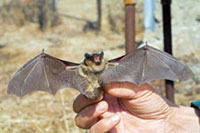 Mist-netting was conducted throughout the training areas of Camp Edwards during the summers of 1999, 2000, and 2001. This survey is continued to determine the species distribution among the different natural communities of Camp Edwards and to aid in the habitat use and home range study.
Mist-netting was conducted throughout the training areas of Camp Edwards during the summers of 1999, 2000, and 2001. This survey is continued to determine the species distribution among the different natural communities of Camp Edwards and to aid in the habitat use and home range study.
Whip-poor-will Survey and Habitat Use and Home Range Project
The Caprimulginae (Aves: Caprimulgiformes: Caprimulgidae) are crepuscular/nocturnal insectivores that occur virtually worldwide (Cleere 1998). In the Nearctic, the subfamily is represented by several species including; the Whip-poor-will ( Caprimulgus vociferus ). Due to its nocturnal habits the Whip-poor-will is one of the most poorly known species in North America . This species is a ground-nester that inhabits oak-pine forests (Cleere 1998); laying two eggs on bare ground (Bent 1940). The Whip-poor-will is double brooded (Cleere 1998). Young are incubated and reared by both sexes, however diurnal incubation is usually by the female (Bent 1940). Males are territorial and will give their characteristic song from song posts within their territories (Bent 1940). Singing activity varies with moonlight (Bent 1940). Feeding is done low, over the ground. Insects are consumed during short sallies from the ground or from perches (Bent 1940). Typical foods include; moths, beetles, crickets, grasshoppers and mosquitoes (Cleere 1998).
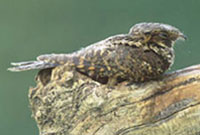 A regional decline in population has been documented over the last several years. The lack of information on this species makes developing management strategies nearly impossible. The study provides data on Whip-poor-will density, micro-habitat (nesting), spatial and overall habitat use and requirements. Data derived from this study is essential for developing Whip-poor-will conservation and management strategies on Camp Edwards (JBCC) and other suitable habitats throughout the region.
A regional decline in population has been documented over the last several years. The lack of information on this species makes developing management strategies nearly impossible. The study provides data on Whip-poor-will density, micro-habitat (nesting), spatial and overall habitat use and requirements. Data derived from this study is essential for developing Whip-poor-will conservation and management strategies on Camp Edwards (JBCC) and other suitable habitats throughout the region.
Areas of highest Whip-poor-will density on Camp Edwards are determined by point counts, and abundance will be determined by the presence of singing males. Ten individuals are captured per year in mist nets and given USFWS leg bands. Tape-playback is used to lure the birds to the nets (Mengel et al. 1972, Mills 1986). The nest site will be found by scanning the area near where each bird is captured for eye shine with hand-held spotlights, and by random encounters. Nests will be monitored periodically throughout the season to determine nesting success. Microhabitat of each nesting site will be examined. The nest sites will be marked. Marking will allow for diurnal determination of vegetative composition of all territories, according to the methods of Dueser and Shugart (1978).
This study focuses on the habitat use by the species and their home range. The relatively large tracts of undisturbed forest on Camp Edwards most likely provide desirable habitat for whip-poor-wills, a species that has declined in abundance due to habitat loss from forest fragmentation, urban development, and lack of wildland fire.
Ten Whip-poor-wills are fitted with radio transmitters per year. Transmitters are affixed using elastic harnesses according to the methods of Brigham (1988) and are retrieved before fall migration. Individuals are tracked three times per week. Observation periods alternate. These periods are 6:00am to 8:00pm, 8:00pm to 1:00am, and 1:00am to 6:00am. These periods allow for the determination of nesting, roosting, and feeding habitats used on Camp Edwards . This information will also be used to determine individual and overall home ranges of Whip-poor-wills on Camp Edwards.
Management efforts are focused on maintaining large unfragmented tracts of land here on Camp Edwards, and when possible increasing the size of theses tracts. Also, through a proactive fire management program habitat diversities will be maintained which is found to be beneficial for this species.
Eastern Box Turtle Habitat Selection and Hibernation Thermal Ecology Research Project
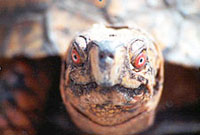 The purpose of the eastern box turtle research project on Camp Edwards, Massachusetts, was to: (1) determine the characteristics of the microhabitats in which the turtles are located and whether or not the turtles select a microhabitat with particular resources or conditions; (2) to quantify the daily movements and home ranges of the turtles; (3) to attempt to determine the abundance of eastern box turtles throughout the various habitats of Camp Edwards. Two important objectives for this project were to standardize the methods of the study so that they may be repeated each year in the future and to successfully monitor the movements and habitat selection of the same ten individual box turtles over the course of multiple (5) years.
The purpose of the eastern box turtle research project on Camp Edwards, Massachusetts, was to: (1) determine the characteristics of the microhabitats in which the turtles are located and whether or not the turtles select a microhabitat with particular resources or conditions; (2) to quantify the daily movements and home ranges of the turtles; (3) to attempt to determine the abundance of eastern box turtles throughout the various habitats of Camp Edwards. Two important objectives for this project were to standardize the methods of the study so that they may be repeated each year in the future and to successfully monitor the movements and habitat selection of the same ten individual box turtles over the course of multiple (5) years.
Eastern box turtles were fitted with radio transmitters during 1998-2004 (n=10) to monitor their movements on Camp Edwards . Turtles were located throughout the summer to determine habitat preferences and the relation of microhabitat characteristics to those of the home range used by the turtle.
Management efforts are focused on maintaining large unfragmented tracts of land here on Camp Edwards and when possible increasing the size of theses tracts. Also, through a proactive fire management program habitat diversities will be maintained which appears to be essential to maintaining healthy populations of box turtles.
Finally, a proactive educational plan has been implemented at Camp Edwards beginning in 1998 to educate Camp Edwards land users to the importance of this species and so that notification is made to the Camp Edwards Natural Resource Office when Box Turtles are found on site. Wanted posters asking to report all box turtle sightings have been placed throughout the JBCC buildings and kiosks. All reports are filed with the Natural Heritage and Endangered Species Program of the Division of Fisheries and Wildlife at the end of the field season.
Amphibian Survey
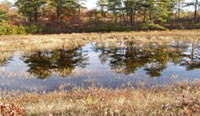 A comprehensive amphibian survey has not been conducted for most wetlands on Camp Edwards. Monument Swamp and Raccoon Swamp were surveyed for three years during spring amphibian migrations, and vernal pool surveys are conducted each year on as many wetlands as feasible. A quantitative survey is conducted on the rest of the major wetland communities to determine the species diversity and abundance throughout Camp Edwards. Surveys have been conducted on the remaining ponds and wetlands as well as the terrestrial communities of Camp Edwards . The surveys are conducted for at least one year, between March and July during the height of the activity (e.g., breeding) period.
A comprehensive amphibian survey has not been conducted for most wetlands on Camp Edwards. Monument Swamp and Raccoon Swamp were surveyed for three years during spring amphibian migrations, and vernal pool surveys are conducted each year on as many wetlands as feasible. A quantitative survey is conducted on the rest of the major wetland communities to determine the species diversity and abundance throughout Camp Edwards. Surveys have been conducted on the remaining ponds and wetlands as well as the terrestrial communities of Camp Edwards . The surveys are conducted for at least one year, between March and July during the height of the activity (e.g., breeding) period.
Reptile Survey
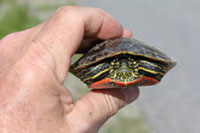 Little effort has been made to systematically document all reptiles that occur on Camp Edwards. Therefore, a comprehensive survey of the reptiles of Camp Edwards is necessary. A survey of the ponds and wetlands Camp Edwards for aquatic turtles has been conducted sporadically in the past. The presence of the spotted turtle in two of the wetlands (Monument and Raccoon Swamp ) of Camp Edwards warrants a more comprehensive survey. The survey will involve live trapping throughout the summer to assess the species diversity and abundance within each of the ponds and wetlands on Camp Edwards. The survey should be conducted for at least one year, between May and July, the height of the active season of the turtles. A survey of terrestrial reptiles may be conducted using pitfall traps with drift fences, plywood boards placed in open, sunny areas, or other appropriate techniques.
Little effort has been made to systematically document all reptiles that occur on Camp Edwards. Therefore, a comprehensive survey of the reptiles of Camp Edwards is necessary. A survey of the ponds and wetlands Camp Edwards for aquatic turtles has been conducted sporadically in the past. The presence of the spotted turtle in two of the wetlands (Monument and Raccoon Swamp ) of Camp Edwards warrants a more comprehensive survey. The survey will involve live trapping throughout the summer to assess the species diversity and abundance within each of the ponds and wetlands on Camp Edwards. The survey should be conducted for at least one year, between May and July, the height of the active season of the turtles. A survey of terrestrial reptiles may be conducted using pitfall traps with drift fences, plywood boards placed in open, sunny areas, or other appropriate techniques.
Grassland Bird Survey
A grassland bird survey was conducted in the cantonment area of the JBCC in 1985, during which one of the largest populations of upland sandpipers in Massachusetts was documented. Since that time, trees and
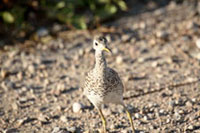 shrubs have colonized much of the grasslands on Camp Edwards. Grassland birds were also surveyed in 1995, 1997, 1998, and 2001-2006. The increase in abundance of Upland Sandpipers and Grasshopper Sparrows can likely be attributed to a change in mowing schedules and subsequent restoration of the cantonment area grasslands. Grassland bird surveys assist in the management of the grasslands by documenting the population sizes and distribution. Surveys are conducted between April and August, the breeding season for most grassland birds.
shrubs have colonized much of the grasslands on Camp Edwards. Grassland birds were also surveyed in 1995, 1997, 1998, and 2001-2006. The increase in abundance of Upland Sandpipers and Grasshopper Sparrows can likely be attributed to a change in mowing schedules and subsequent restoration of the cantonment area grasslands. Grassland bird surveys assist in the management of the grasslands by documenting the population sizes and distribution. Surveys are conducted between April and August, the breeding season for most grassland birds. Odonate Survey
Surveys for dragonflies and damselflies have been conducted since 1995, The presence of five state-listed rare odonate species on Camp Edwards justify the necessity to conduct a comprehensive survey to determine species distribution and to identify not only the aquatic habitats, but also the upland habitats used by the species. A comprehensive survey should be conducted for at least one year, between May and August to encompass all of the flight periods of the state-listed rare odonates on Camp Edwards.
American Burying Beetle Survey
The American burying beetle (Nicrophorus americanus ) is a federally-listed rare insect species; the geographic range of which has historically included Massachusetts. The relatively close proximity of an identified population in Rhode Island and large tracts of undisturbed open woodland forest on Camp Edwards provide a likely possibility of the species occurring on Camp Edwards . A survey for American burying beetles on Camp Edwards would be conducted under the guidance of NHESP.
New England Cottontail Survey
On August 30th, 2000, the U.S. Fish and Wildlife Service received a petition requesting the need to list the New England Cottontail (Sylvilagus transitionalis ) as a threatened or endangered species. Findings indicated that the petitioned action may be warranted and that a full status review is needed. Consequently, the New England Cottontail is officially acknowledged as a species in need of conservation attention (as a candidate species).
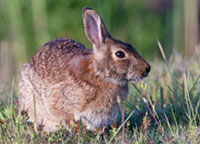 The New England Cottontail is a medium sized cottontail rabbit, weighing approximately 2.2 lbs. It can be distinguished from its counterpart, the Eastern Cottontail by several features including pelage color, body size, and skull characteristics. The external characteristics of pelage and body size are not 100% reliable; however, the skull characteristics are very trustworthy. This lagomorph is considered an early successional forest species with suitable habitat comprising both of forested and shrub lands with dense understory growth.
The New England Cottontail is a medium sized cottontail rabbit, weighing approximately 2.2 lbs. It can be distinguished from its counterpart, the Eastern Cottontail by several features including pelage color, body size, and skull characteristics. The external characteristics of pelage and body size are not 100% reliable; however, the skull characteristics are very trustworthy. This lagomorph is considered an early successional forest species with suitable habitat comprising both of forested and shrub lands with dense understory growth. With the introduction of the Eastern Cottontail in 1930's, fragmentation of habitat as the human population grows, and higher predation and hunting rates as the habitat is more and more fragmented, have all contributed to the decline of this species. It has been found that large patches of habitat, like that of Camp Edwards, are essential for sustaining populations of this species.
Camp Edwards is considered, by some, to be the stronghold for this species on Cape Cod. A baseline survey was conducted on Camp Edwards in 2006 to provide information on population status and habitat requirements on Camp Edwards.
Invasive Species
The Camp Edwards Training Site, of the Massachusetts Army National Guard, consists of nearly 15,000 acres of undeveloped land, and is located on upper Cape Cod. Traditionally this natural community has had few invasives. With the increased development of Cape Cod in the past 30 years, and more recently, the groundwater restoration activities, invasives have been increasingly observed along roadsides and remediation sites. Locations of most roadside and remediation site invasives have been mapped with GPS units. With this spatial information, we can analyze what invasives we have, in what concentrations we have them, and where they are located. This is helping us to choose the right tool (stump and paint, injection, prescribed fire, etc.) to manage invasives in order to improve the natural community and mission-scape at Camp Edwards.
Camp Edwards Box Project
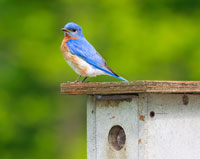 Camp Edwards, with the aid of the Senior Environmental Corps (SEC), maintains a bluebird trail in the cantonment area. In addition to bluebird boxes, bat/duck boxes were built and placed into the wetlands of the training area. These boxes provide nesting habitat for up to two wood duck pairs and additional space for 1000's of roosting bats. To date, there are several bats in four of the boxes located on Donnelly Pond, Baileys Pond, Little Halfway Pond, and Rod and Gun Club South Pond. These boxes will be maintained and monitored yearly for species use and success with the aid of the SEC.
Camp Edwards, with the aid of the Senior Environmental Corps (SEC), maintains a bluebird trail in the cantonment area. In addition to bluebird boxes, bat/duck boxes were built and placed into the wetlands of the training area. These boxes provide nesting habitat for up to two wood duck pairs and additional space for 1000's of roosting bats. To date, there are several bats in four of the boxes located on Donnelly Pond, Baileys Pond, Little Halfway Pond, and Rod and Gun Club South Pond. These boxes will be maintained and monitored yearly for species use and success with the aid of the SEC.